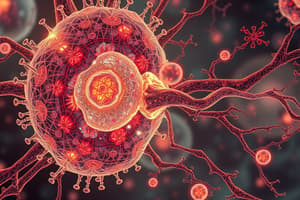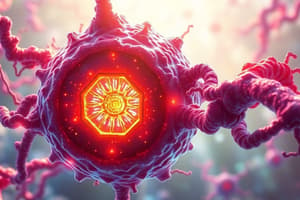Podcast
Questions and Answers
Which of these is a receptor molecule?
Which of these is a receptor molecule?
- Option A
- Option B (correct)
- Option C
- Option D
A signal transduction pathway is initiated when a _____ binds to a receptor.
A signal transduction pathway is initiated when a _____ binds to a receptor.
signal molecule
Which of these is a signal molecule?
Which of these is a signal molecule?
- Option A (correct)
- Option D
- Option C
- Option B
A signal molecule is also known as a(n) _____
A signal molecule is also known as a(n) _____
Which of these is the second of the three stages of cell signaling?
Which of these is the second of the three stages of cell signaling?
What are the three stages involved in the process of a signal converting to a specific cellular response?
What are the three stages involved in the process of a signal converting to a specific cellular response?
Describe the interaction of cortisol with intracellular receptors.
Describe the interaction of cortisol with intracellular receptors.
Which of the following are plasma membrane receptors?
Which of the following are plasma membrane receptors?
What do G protein-coupled receptors do?
What do G protein-coupled receptors do?
What do receptor tyrosine kinases do?
What do receptor tyrosine kinases do?
G protein-coupled receptors and receptor tyrosine kinases both have their binding sites for signaling molecules on the intracellular side of the cell.
G protein-coupled receptors and receptor tyrosine kinases both have their binding sites for signaling molecules on the intracellular side of the cell.
Which statements are true about the binding of histamine to the histamine H1 receptor?
Which statements are true about the binding of histamine to the histamine H1 receptor?
Which of these acts as a second messenger?
Which of these acts as a second messenger?
Calcium ions that act as second messengers are stored in _____.
Calcium ions that act as second messengers are stored in _____.
_____ catalyzes the production of _____, which then opens an ion channel that releases _____ into the cell's cytoplasm.
_____ catalyzes the production of _____, which then opens an ion channel that releases _____ into the cell's cytoplasm.
What is amplification in cell signaling?
What is amplification in cell signaling?
Which of the following lists represents the stages of signal transduction?
Which of the following lists represents the stages of signal transduction?
Which of the following could account for the different cellular responses to histamine?
Which of the following could account for the different cellular responses to histamine?
What is apoptosis?
What is apoptosis?
Flashcards are hidden until you start studying
Study Notes
Receptor Molecules and Signal Transduction
- Receptor molecules are essential for cell signaling, with examples including G protein-coupled receptors and receptor tyrosine kinases.
- A signal transduction pathway is triggered by a signal molecule (ligand) binding to a receptor, leading to a series of cellular responses.
Stages of Cell Signaling
- The process encompasses three stages:
- Reception: signaling molecule binds to receptor.
- Transduction: signal converted to a cellular response.
- Response: triggered cellular activities, often involving gene expression.
Hormonal Interaction
- Cortisol, a steroid hormone, passes through the plasma membrane, binds to intracellular receptors, forms a complex, and enters the nucleus to influence gene transcription.
Types of Receptors
- Plasma Membrane Receptors include:
- G protein-coupled receptors, which interact with G proteins.
- Receptor tyrosine kinases, which form dimers and transfer phosphate groups to the receptor itself.
Mechanisms of Action
- G protein-coupled receptors and receptor tyrosine kinases manage signaling on the extracellular side and are located within the plasma membrane.
- Histamine binding to H1 receptors initiates a conformational change that activates G proteins, which then interact with phospholipase C.
Second Messengers and Amplification
- Examples of second messengers include cyclic AMP and calcium ions, which facilitate downstream signaling.
- Amplification occurs when a single activated protein kinase cascades to activate multiple other kinases.
Cellular Responses and Variability
- Different responses to histamine arise due to varying second messengers, enzymes activated by G proteins, relay molecules, and cell types expressing histamine receptors.
Apoptosis
- Apoptosis refers to controlled cell suicide, a crucial process for maintaining cellular health and development.
Studying That Suits You
Use AI to generate personalized quizzes and flashcards to suit your learning preferences.




